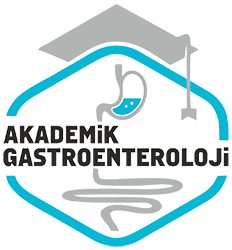Aralik 2015
Özofageal heterotopik gastrik mukoza: ne kadar sik? Ne kadar önemli? Bir vaka-kontrol çalismasi
Oesophageal heterotopic gastric mucosa: how often? How important? A case-control study
- Ana Sayfa
- Sayılar
- Aralik 2015
- Özofageal heterotopik gastrik mukoza: ne kadar sik? Ne kadar önemli? Bir vaka-kontrol çalismasi...
Özet
Giriş ve Amaç: Heterotopik gastrik mukoza genellikle servikal özofagusta yerlesen, çogunlukla asemptomatik olan ve ilerleyici olmayan kolumnar mukozal adaciktir. Çalışmamızda klinigimizde endoskopik olarak heterotopik gastrik mukoza tanısı konan vakalarin klinikopatolojik özelliklerini değerlendirmeyi amaçladık. Gereç ve Yöntem: çalışmada Ocak 2009-Aralık 2013 tarihleri arasında gastroskopi yapılan vakalarin verileri retrospektif olarak incelendi. Endikasyonu bilinmeyen, mükerrer ve acil vakalar çalışma dışı bırakıldı. Epidemiyolojik analizler sonrasi dispepsi yakinmasi ile gastroskopi yapılan gruptan heterotopik gastrik mukoza olgulari ile yaş ve cinsiyet eslenik bir kontrol grubu olusturuldu. Heterotopik gastrik mukoza ve kontrol grubunun klinikopatolojik özellikleri karsilastirildi. Bulgular: çalışmaya 7244’ü kadın (%56.7) toplam 12.767 hasta alındı. Hastaların yaş ortalaması 52.4±16.5 yıl idi. 137 vakada (%1.1) heterotopik gastrik mukozaya rastlandi. Vakalarin %90.1’i proksimal özofagusta idi. Heterotopik gastrik mukoza orani en yüksek islem endikasyonlari; Barrett özofagus kontrol (%6.5), üst özofageal semptomlar (%2) ve bulanti kusma (%1.7) idi. Heterotopik gastrik mukoza prevalansi kadınlarda %0.7 iken erkeklerde %1.5 bulundu (p<0.01). Heterotopik gastrik mukoza grubunun yaş ortalaması nonheterotopik gastrik mukoza grubuna göre anlamli biçimde düşüktü (47.9±15 ve 52.5±16, p<0.01). Sonuç: Tedaviye dirençli üst özofageal şikayetleri olan, 50 yaşin altındaki erkek olgularda ve Barrett özofagusu öyküsü olan hastalarda heterotopik gastrik mukoza bulunma ihtimali daha yüksektir.
Abstract
Background and Aims: Heterotopic gastric mucosa is a columnar mucosal islet, commonly located in the cervical esophagus, that is usually asymptomatic and nonprogressive. In this study, we aimed to evaluate the clinicopathological features of heterotopic gastric mucosa cases in our clinic that were diagnosed using endoscopy. Materials and Method: In this study, we retrospectively analyzed data from patients who underwent gastroscopy between January 2009 and December 2013, excluding procedures performed for unknown indications, or repeated, or urgent gastroscopies. After completing epidemiological analysis, an age and gender matched control group was attained from patients whose gastroscopy was done due to dyspepsia. We compared clinicopathological characteristics of the heterotopic gastric mucosa and control groups. Results: A total of 12.767 patients, 7.244 (56.7%) female, were included in the study. Mean patient age was 52.4±16.5 years. Heterotopic gastric mucosa accounted for 137 (1.1%) of the cases. Ninety percent were in the proximal esophagus. The highest heterotopic gastric mucosa rates in follow up examiniations were idenntified as: Barrett’s esophagus (6.5%), upper esophageal symptoms (2%), and nausea/vomiting (1.7%). Heterotopic gastric mucosa prevalence was 0.7% in females and 1.5% in males (p <0.01). The average age of the heterotopic gastric mucosa group was significantly younger than the non- heterotopic gastric mucosa group (47.9±15 and 52.5±16, p <0.01). Conclusion: The presence of heterotopic gastric mucosa was more frequent in patients with upper oesophageal symptoms resistant to treatment; male patients under 50 years of age; and, in patients with a history of Barrett’s esophagus



